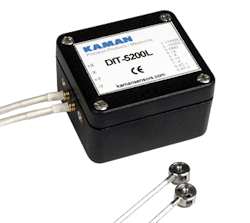Displacement measuring system for servo control in uses like laser communications introduced by Kaman
MIDDLETOWN, Conn. – The Measuring Division of Kaman Precision Products Inc. in Middletown, Conn., is introducing the DIT-5200L non-contact displacement measuring system for fast-steering mirrors, servo control position feedback, stage positioning, angular displacement indication, X-Y orbit position feedback, and stylus position.
The DIT-5200L provides advanced precision measurement technology with resolution, repeatability, and nulling accuracy. Applications for the DIT-5200L include laser communications, optical stabilization, and magnetic bearings.
The DIT-5200L features enhancements for low noise, high resolution, and CE marking. Capable of sub-nanometer resolution, the DIT-5200L provides thermal stability of plus-or-minus 0.03 percent and sensitivity to 10 volts per mil, or 39 millivolts per micron.
With a package size of 7.7 cubic inches, the DIT-5200L is linear to 0.1 percent of the full range, and is available in single- and dual-channel configurations.
The DIT-5200L signal conditioning electronics is packaged in a die cast aluminum box with MCX style sensor connections. I/O is on a nine-pin mini-D connector. The input power connections are reverse voltage protected.
The DIT-5200L non-contact displacement measuring system is built from commercial off-the-shelf (COTS) components, so Kaman can produce it at a relatively low cost and in a relatively high volume.
The DIT-5200L uses high precision eddy current balanced bridge technology for detecting the aligned/centered position of a conductive target relative to a pair of non-contacting sensors.
For differential measurement applications, two precisely matched sensors per channel are positioned on opposite sides or ends of a target. In this sensor-to-target relationship, as the target moves away from one sensor, it moves toward the other sensor an equal amount.
Output is differential and bipolar. Electrically matched sensors on opposing legs of the same bridge provide thermal stability. For more information contact the Measuring Division of Kaman Precision Products online at www.kamansensors.com.
